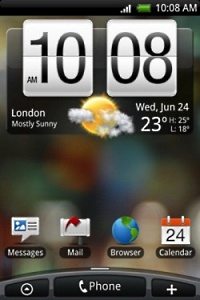 With the release of the Motorola Droid, it’s becoming clear that 2010 is going to be a very exciting year for Google Android. The operating system is now two years old, and Android 2.0 has begun shipping with new phones.
With the release of the Motorola Droid, it’s becoming clear that 2010 is going to be a very exciting year for Google Android. The operating system is now two years old, and Android 2.0 has begun shipping with new phones.
Gone are the growing pains of introducing a new mobile platform in an iPhone-dominated marketplace and dealing with shoddy first-generation hardware. Now Google, along with the other members of the Open Handset Alliance, can focus on spreading the word of Android with better phones, better software, and an increased presence in the public consciousness.
Here are ten predictions for what will happen with Google Android in 2010.
1. Many more phones to choose from
 Okay, this may be completely obvious, but it’s worth stating – 2010 will see the release of more Android phones than we’ve ever seen before.
Okay, this may be completely obvious, but it’s worth stating – 2010 will see the release of more Android phones than we’ve ever seen before.
HTC led the charge with the G1 and G2 (a.k.a. the MyTouch 3G in America), and let’s not forget the recently released Hero on Sprint and the Droid Eris on Verizon. HTC has generally proven themselves to be purveyors of high quality phone design, and despite the issues with the G1’s design (which were rumored to stem from Google’s input), they’ve certainly set the bar for Android handset makers. Motorola met that challenge with the Droid, and also made a decent, but not quite successful, stab with the Cliq.
At this point, future Android handset makers have a lot to live up to. Wikipedia’s current list of upcoming Android phones isn’t very large right now, and it’s filled with a bunch of no-name manufacturers, but I suspect we’ll be seeing many new announcements in the next few months.
The most promising upcoming Android phone is Sony Ericsson’s XPERIA X10 (image to the right), which will boast a 1Ghz processor, 8MP camera, and an insanely large 4″ display. All of these specs best the Droid, and it’s surely a sign of further innovation coming to the platform.
On T-Mobile we’ll most likely see a refresh of the G2, as well as better keyboard-equipped options than the Cliq. Sprint already has the Hero, and will certainly add more to compete with the other carriers. Even AT&T is getting in on the fun with Dell’s upcoming handset.
2. App development will take off, and iPhone apps will cross over
It’s hardly a revelation that the Android Market will see many more apps coming in 2010. What’s more interesting to me is where they could potentially be coming from. We’ll definitely see further amateur and independent development specifically for Android, but I also think we’ll be seeing many more releases from bigger software houses and more conversions of popular iPhone apps.
The hype surrounding the Droid will certainly inspire some developers, and I’m sure more will jump on the Android bandwagon as more phones are announced.
3. Android will show up on many other devices
Part of the beauty of Android is that it’s not just limited to cellphones. Google has crafted a lightweight operating system that could do well on many other devices. We’ve already seen Android implemented on the Archos 5 portable media device, as well as the Barnes and Noble Nook eBook reader. In 2010 we can look forward to it showing up on netbooks (Acer already has one planned), and I wouldn’t be surprised to see it popping up on Internet tablet devices either.
4. A more polished and stable Android OS
Again, another seemingly obvious, yet important point: 2010 will be the year that Android matures from its initial ugly duckling phase. Android 2.0 already looks a lot better than its predecessors, but even that is still a bit rough around the edges. We can expect further refinement down the line. As the OS matures, we’ll also see more complex applications developed, including more support for 3D games.
5. Android hardware will improve faster than the iPhone
One aspect of the Android vs. iPhone debate that isn’t mentioned very often is that Android isn’t tied to Apple’s annual refresh cycle. Handset manufacturers can release phones whenever they like, which means they can constantly try to one-up each other throughout the year. The Sony XPERIA X10 already trounces the Droid’s hardware, and even though it doesn’t have a release date yet, we knew it was coming months before the Droid launch.
We’re only about six months away from the release of the iPhone 3GS, and the Droid is already sporting a higher megapixel camera, a larger screen, and managed to fit in a real keyboard in a frame not that much thicker than the iPhone’s.
I’m not saying we’ll be seeing phones going obsolete every few months, but I wouldn’t be surprised if 2010 features at least three Android phones that significantly raise the bar for the platform.
6. More exclusive content from Google
 The unveiling of Google Maps Navigation right amidst the pre-launch Droid frenzy was no accident. Google knew it had a killer app on their hands, and conveniently made it one of the biggest selling points for the Droid. The app requires Android 2.0, and since the Droid is the only phone on the market right now featuring it, Google basically handed the phone an exclusive.
The unveiling of Google Maps Navigation right amidst the pre-launch Droid frenzy was no accident. Google knew it had a killer app on their hands, and conveniently made it one of the biggest selling points for the Droid. The app requires Android 2.0, and since the Droid is the only phone on the market right now featuring it, Google basically handed the phone an exclusive.
We’ll surely see Google Maps Nav on future Android 2.0 devices, and I’m fairly certain Apple will end up bringing it over to the iPhone as well.
The important point here is that it showed up on Android first, and it will probably take months for it to get to the iPhone. There’s nothing stopping Google from pulling the same stunt with many other killer apps down the line.
7. No more multi-touch hesitation
Google needs to stop playing it safe, grow some cojones, and pull a Palm when it comes to multi-touch support on Android. To their credit, multi-touch is indeed built into Android 2.0, but even with that the Motorola Droid still lacks pinch-zoom gestures for web browsing, Google Maps, and other applications. The issue is even more muddy because the gestures work fine in other downloaded apps.
This may not be entirely Google’s fault: CNET points out that both Google and Motorola seem to be hinting that Verizon killed the feature (consider the fact that it remains intact for the European Droid). But even if it was Verizon that nixed the gestures, Google should have remained firm and convinced them otherwise. At the very least, they need to make sure this never happens again.
As for devices not featuring Android 2.0, it’s currently up to handset manufacturers to implement multi-touch. HTC has done it with the Hero and Eris – which is particularly ironic because the Eris is being sold as the cheaper, less feature-rich option to the Droid.
8. Ramped-up Android marketing
Google, along with the Android carriers and manufacturers, won’t play it quiet in 2010 like they did this year. This is also the logical outcome from having more Android devices released in 2010.
To be fair, there wasn’t much to market this year until the G2 was announced and released, but come next year they won’t have that excuse. They need to cement Android as the non-iPhone option. Judging from the New York turnout for the Droid’s midnight release, I believe that mindshare shift has already started.
9. Expect converts from the Blackberry and Windows Mobile camps
Many think of the iPhone as the big bad guy opposing Google’s noble open-source endeavor, but let’s not forget that a significant portion of smartphone users are using Blackberry and Windows Mobile phones.
Both RIM and Microsoft are struggling to keep pace with the rapid evolution of modern smartphones. The Blackberry Storm 2 was indeed a better phone than its predecessor, but it’s not something that would make people jump carriers, let alone switch phones. The release of Windows Mobile 6.5 was a crushing disappointment, and we won’t see a decent modern Windows Mobile OS until 7.0 comes out in 2010.
That leaves a lot of disgruntled users who are constantly seeing better phones in ads, as well as among their friends and family. I predict we’ll see a high defection rate to Android from these users who’ve obviously avoided the iPhone for one reason or another. This defection rate will be higher than for people switching from the iPhone to an Android phone. And when Android manages to implement security measures and Exchange support on the level of Blackberry, the corporate IT world will surely pay attention as well.
10. More custom interface tweaks
 HTC sexed up Android with their Sense UI interface on the Hero and Eris, and it certainly won’t be the last time they do so.
HTC sexed up Android with their Sense UI interface on the Hero and Eris, and it certainly won’t be the last time they do so.
I suspect we’ll be seeing other manufacturers putting their own unique spin on Android’s interface in 2010, if only to stand out from the crowd. With more phones being released, the manufacturers are going to have to differentiate themselves in ways aside from hardware, and creating a unique user interface is one of the most obvious ways to do so.
The previously mentioned Sony Ericsson XPERIA X10, for example, will be sporting a modified Android installation they’re calling “UX”. Judging from the video and pictures of the device in action, it’s clearly far more attractive than the current Android 2.0 interface.
Final notes
Some of these predictions are almost certain to happen, while others are just hopeful speculation. Whatever happens, 2010 will be quite a year for those interested in mobile devices. Palm will need to deliver a doozy of a follow-up to the Pre to remain relevant, Microsoft needs to make sure Windows Mobile 7 is damned impressive (and find handsets to put it on), and RIM simply has to figure out what on Earth they’re doing.
And then there’s Apple, whose reaction to Android’s growth will probably be the most interesting of all. Apple was able to deflect Palm’s growth by releasing the iPhone 3GS very soon after the Pre’s launch, but they’ve yet to make a direct response to any Android device. 2010 will certainly be the year for them to do so – the only question now is how Apple will respond.
About the author:
Devindra Hardawar is a tech/film blogger and podcast host. You can find him writing at the Far Side of Tech and Slashfilm.



























